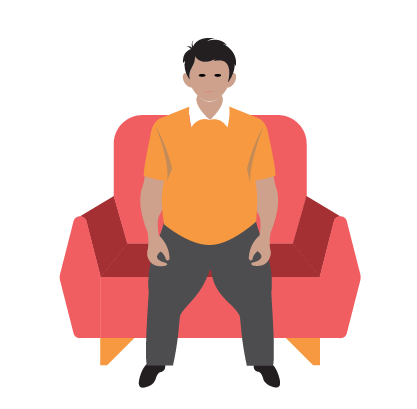You are here
Risky Business: Exercise Extremes
It seems odd to talk about exercise as a risky activity, but when a person doesn’t exercise enough or exercises too much, it has consequences for both physical and mental health.
Not Enough |
|
 |
When a person does not regularly exercise or does not meet the bare minimum recommendations for physical activity as outlined by the Centers for Disease Control and Prevention (CDC), it is called having a sedentary lifestyle. [1] |
 |
of adults DO NOT meet the guidelines for both aerobic and muscle-strengthening activities. [2] |
Too Much |
|
 |
When a person misses important social or professional obligations so they can workout; feels extremely sad or guilty when they don’t exercise; doesn’t give their body time to recover after an intense workout; or continues to exercise despite illness or injury, it is called compulsive exercise, or exercise addiction. [3] |
 |
of people meet the criteria for behavioral addiction to exercise. [4] |
What is the recommended amount of exercise?
The recommended amount of exercise for an adult includes aerobic activity and muscle strengthening activities. [5]
Aerobic Activity
| Aerobic activity must be done for at least 10 minutes at a time to have an impact. |  |
The minimum amount of aerobic activity that should be done in a week depends on the intensity of the exercise. |
150-300
|
 |
75-150
|
| Moderate-intensity aerobic activity (heart rate is raised, light sweating, should be able to talk but not sing) | Vigorous-intensity aerobic activity (heart rate is raised significantly, heavy sweating, can’t say more than a few words at a time) . |
Muscle-strengthening
2 or more days per week |
||
 |
Muscle-strengthening activities that work all major muscle groups (legs, hips, back, abdomen, chest, shoulders, and arms) |  |
What are the health risks of too much or not enough exercise?
Too Much [6] |
Not Enough [7] |
||
 |
Dehydration & fatigue |  |
Colon & breast cancer |
 |
Increased injuries, cartilage damage & arthritis |  |
Obesity |
 |
Fractured bones & osteoporosis |  |
Diabetes |
 |
Irregular periods & reproductive issues |  |
Cognitive decline & depression |
 |
Heart problems |  |
Heart attack & stroke |
How is exercise related to mental illness?
| Sedentary lifestyle may be a symptom of depression or anxiety when coupled with withdrawal from activities that one used to enjoy or social isolation. Additionally, living a sedentary lifestyle increases a person’s risk of developing depression. |  |
| When compulsive exercise is used as a way to “purge” calories that have been consumed, it can be a symptom of an eating disorder. [8] |  |
| Eating disorders often accompany exercise addiction. Approximately 39-48% of people who have an eating disorder also struggle with exercise addiction. [9] |  |
Get moving
If you’ve been living a sedentary lifestyle and want to get started with an exercise program:
- Talk to your doctor to see if there are any special considerations you should take when exercising.
- Start slow and work up to harder activities.
- Find a friend to exercise with to keep you motivated and accountable.
Take control of compulsive exercise
- Take days off from exercising or substitute your normal routine with less strenuous workouts.
- Remind yourself that a certain body type or weight will not automatically lead to happiness.
- Avoid negative self-talk like, “You’re a lazy slob if you don’t go to the gym,” or, “Nobody will want to date you with a body like that.”
- Make sure you are eating enough to fuel your body for exercise.
- Tell a trusted friend or family member about your struggles. Make plans to do something besides workout a couple of days each week.
- Know when to seek professional help.
If you need help
 |
Take a screen at mhascreening.org to determine if you are experiencing signs of an eating disorder or another underlying mental illness. Use the results to start a conversation with your health care provider. |
 |
Seek specialized treatment. You can find treatment providers using the online SAMHSA Treatment Locator at findtreatment.samhsa.gov or by calling the SAMHSA 24/7 Treatment Referral Line 1-800-662-HELP(4357). |
If you or a loved one is in a mental health crisis, please either visit your local Emergency Room, call 911, reach out to The National Suicide Prevention Lifeline's 24 hour toll-free crisis hotline, 1.800.273.TALK (1.800.273.8255), or text "MHA" to 741741 to receive text-based crisis help.
Sources
SOURCES
[1,5] https://www.cdc.gov/physicalactivity/basics/adults
[2] https://www.fitness.gov/resource-center/facts-and-statistics
[3,8] https://www.allianceforeatingdisorders.com/portal/compulsive–over–exercise
[4] https://www.ncbi.nlm.nih.gov/pmc/articles/PMC3210598
[6] https://uhs.berkeley.edu/sites/default/files/bewell_cmpvexc.pdf
[7] http://www.nchpad.org/403/2216/Sedentary~Lifestyle~is~Dangerous~to~Your~Health
[9] Freimuth, M., Moniz, S., & Kim, S. R. (2011). Clarifying Exercise Addiction: Differential Diagnosis, Co-occurring Disorders, and Phases of Addiction. International Journal of Environmental Research and Public Health, 8(10): 4069–4081.









this page